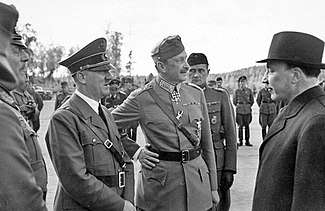Hitler and Mannerheim recording
The Hitler and Mannerheim recording is a voice recording of a private conversation between Adolf Hitler, Führer of Nazi Germany, and Carl Gustaf Emil Mannerheim, Commander-in-Chief of the Finnish Defence Forces, during a secret visit honoring Mannerheim's 75th birthday on 4 June 1942 during the Continuation War, a sub-theater of World War II. Thor Damen, an engineer for the Finnish broadcasting company Yle, recorded the first 11 minutes of Hitler and Mannerheim's private conversation. Damen had been assigned to record the official birthday speeches and Mannerheim's responses. However, Damen continued recording—without Hitler's knowledge—after the conversation switched from official to private. It is the only known recording of Hitler speaking in an unofficial tone.

Visit by Hitler
In June 1941, Nazi Germany invaded the Soviet Union. Despite the initial and overwhelming success of the campaign, the Soviets repulsed the German assault on Moscow and stalled the German advance.[1][2][3] Hitler required his allies to tie down as much of the enormous Soviet military machine as possible.[4] In 1942, Hitler, under extreme secrecy, visited Finland, officially to congratulate Mannerheim on his 75th birthday.[5][2] Mannerheim did not wish to greet Hitler at his headquarters, as it would have appeared like a state visit.[6] Therefore, the meeting occurred at Imatra in Southern Finland.[7] At Immola Airfield, Hitler was greeted and accompanied by President Ryti and other state and military officials to Mannerheim's personal train, where a birthday meal and negotiations took place.[5][2]
Microphone

After the official greetings and speeches had taken place, Hitler and Mannerheim, accompanied by other German and Finnish officials, entered Mannerheim's private wagon for cigars, drinks and lunch.[6][8] In this wagon, a large and visible microphone had been set up by the Finnish sound engineer, Thor Damen. The microphone recorded the first 11 minutes of Hitler's private conversation with Mannerheim.[6][8] On the tape, Hitler discusses the failure of Operation Barbarossa, Italian defeats in Africa, Yugoslavia, and Albania, his surprise of the Soviet Union's ability to produce thousands of tanks, and his strategic concerns about Romanian petroleum wells.[8]
Damen had been assigned to record Hitler's official speech and birthday message to Mannerheim. Hitler was unaware that the microphone was still recording after the official speeches, but Damen continued to record the now-private conversation.[5][2][8] After 11 minutes, Hitler's SS guards realized what Damen was doing. They made a cutthroat gesture to demand that he cease recording.[2][5][6][8] The SS guards demanded the tape be destroyed, but Yle was allowed to keep the tape in a sealed container, promising never to open it again.[2][6][8] The tape was given to the head of the state censors' office, Kustaa Vilkuna, returned to Yle in 1957, and made publicly available a few years later. It is the only known recording of Hitler speaking in an unofficial tone and one of the very few recordings in which Hitler may be heard delivering a narrative without raising his voice.[8]
Authenticity
After the tape was revealed to the public, some believed it was a fake because Hitler's voice sounded too soft.[5] Photographs taken on the day of the event showed that Hitler had been drinking alcohol, which could have affected his voice, as he rarely drank.[9] After listening to the recording, Rochus Misch, Hitler's former bodyguard and radio operator, said:
"He is speaking normally, but I'm having problems with the tone; the intonation isn't quite right. Sometimes it seems okay, but at other points not. I have the feeling it's someone mimicking Hitler... It really sounds as if someone is mimicking him."[5]
— Rochus Misch
The BKA (German Federal Criminal Police Office) later examined the tape, and Head of Frequencies Dr. Stefan Gfroerer declared that it is "very obvious to us that this is Hitler's voice."[5]
In popular culture
The other of Mannerheim's saloon coaches, where the meeting took place is displayed outside a Shell service station by Finnish national road 12 in Sastamala. It has been open to the public since 1969.[10]
The private wagon, where the recording took place, is located in Mikkeli. It is open to public only once a year, on 4 June, Mannerheim's birthday.[11]
The recording was used by Swiss actor Bruno Ganz when he rehearsed Hitler's manner of speaking for his role in the 2004 film Downfall.[6]
References
Notes
- Reinhardt 1992, p. 227.
- Chapman, Clare (15 October 2004). "Finnish Radio To Air Unique Hitler Recording"". The Guardian. Retrieved 15 June 2014.
- Glantz, David M. (11 October 2001). The Soviet-German War 1941-1945: Myths and Realities: A Survey Essay. A Paper Presented as the 20th Anniversary Distinguished Lecture at the Strom Thurmond Institute of Government and Public Affairs. Clemson University. Archived from the original on 18 February 2015. Retrieved 12 June 2014.
- Virkkunen 1994, p. 41
- Staff (ndg) "Hitler's Secret Voice Recording" Archived 2017-03-12 at the Wayback Machine. National Geographic. Retrieved 2017-03-10.
- "Conversation Secretly Recorded in Finland Helped German Actor Prepare for Hitler Role". Helsingin Sanomat. Retrieved 2014-24-04.
- Weinberg 1980, p. 195
- Lindfors, Jukka (2017-06-05). "Hitlerin salaa tallennettu keskustelu Suomessa". Yle (in Finnish). Retrieved 2018-04-29.
- Dietrich 2010, p. 171.
- "Marskin Salonkivaunu" (in Finnish) Kiskokabinetti. Retrieved 10 September 2014.
- "Marsalkka Mannerheimin salonkivaunu" [The saloon car of Marshal Mannerheim]. salonkivaunu.mikkeli.fi. Retrieved 2019-06-26.
Bibliography
- Dietrich, Otto (2010). The Hitler I Knew: Memoirs of the Third Reich's Press Chief. New York: Skyhorse. ISBN 978-1-60239-972-3.CS1 maint: ref=harv (link)
- Reinhardt, Klaus (1992). Moscow – The Turning Point: The Failure of Hitler's Strategy in the Winter of 1941–42. Oxford: Berg Publishers. ISBN 978-0-85496-695-0.CS1 maint: ref=harv (link)
- Virkkunen, Sakari (1994). Presidents of Finland II. Helsinki, Otava. ISBN 978-3-8329-5609-7.CS1 maint: ref=harv (link)
- Weinberg, Gerhard (1980). The Foreign Policy of Hitler's Germany Starting World War II. Chicago, Illinois: Chicago Press. ISBN 978-0-226-88511-7.CS1 maint: ref=harv (link)
External links
| Wikimedia Commons has media related to Hitler's conference with Mannerheim. |
- The full Hitler and Mannerheim recording at Yle public broadcasting company's archive (in Finnish)